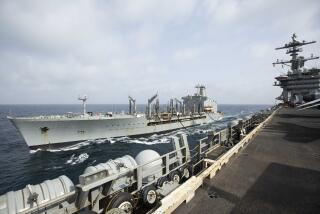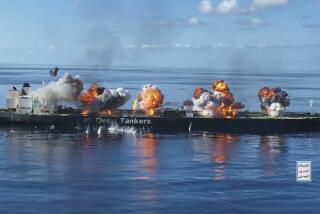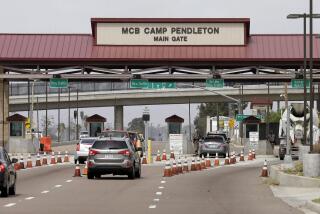10 U.S. Sailors Killed in Ship Accident in Gulf
DHAHRAN, Saudi Arabia — A burst of superheated steam killed 10 American sailors Tuesday in a boiler-room accident aboard a Navy assault ship, forcing a scale-back of a new exercise testing a possible amphibious landing in the Persian Gulf conflict.
The break in a high-pressure steam line came just minutes after the 29-year-old Iwo Jima pulled out of port in Manama, Bahrain, where it had undergone five days of repairs, according to military officials here.
All 10 seamen on duty in the boiler room at the time were apparently showered with scalding liquid and vapor that spewed across the room under pressure at temperatures of as much as 850 degrees. After the accident, which occurred as the vessel was leaving harbor, the Iwo Jima and its 1,100 Marines withdrew from participation in a massive amphibious landing exercise that began Tuesday on a beachhead in the sheikdom of Oman.
The fatal blast came as another serviceman was reported killed and six others were injured in two military accidents ashore, one of them involving a Marine sentry who shot at three U.S. sailors as they approached his guard station.
The shooting, which the military said appeared to be accidental, left one seaman in serious condition with wounds from machine-gun fire and two others suffering from less serious injuries.
In the other incident, a Humvee (highly mobile multi-purpose vehicle) plunged over a 20-foot desert embankment during a nighttime training mission, killing one Marine and injuring three others.
The series of accidents brought to 42 the number of U.S. servicemen killed since the buildup began.
The 11 American deaths in a single day ended three weeks without an accident since the Army and Air Force, in response to a series of fatal aircraft mishaps, imposed strict limits on night flying.
Since the restrictions were imposed, there have been no serious aircraft accidents involving either service. But some officers have raised concerns about the prohibitions, which force Army helicopters to maintain an altitude of 150 feet and Air Force aircraft to stay above 1,000 feet. They complain that the restrictions rule out maneuvers essential to combat training.
The burst steam line in the No. 2 boiler room of the 602-foot Iwo Jima, which occurred at 8:15 a.m. local time, caused the largest number of deaths in a single incident in the Persian Gulf theater to date.
It occurred with the ship a little more than a mile out of Bahrain on its way to a rendezvous with 17 other Navy amphibious vessels to begin a weeklong amphibious assault exercise on a remote beachhead in the northern Arabian Sea.
The operation, code-named Sea Soldier Two, involves 95 aircraft and thousands of Marines. It had been expected to be even larger than last month’s Operation Camel Sand, the first trial for an amphibious landing in the desert, military officials said.
But the forced withdrawal of the Iwo Jima from the operation eliminated one of the three largest ships and more than 10% of the Marines in the floating task force, which has been deployed at sea since mid-September in preparation for a possible amphibious assault on Iraqi-held Kuwait.
With no immediate indication of the cause of the accident, the ship’s captain immediately ordered both boilers shut down and the vessel towed back to port for further repairs, Navy officials said.
Six of the sailors were killed immediately, and their bodies were flown back to the United States. Two others died several hours later aboard the Navy hospital ship Comfort, and the remaining two seamen died aboard the same vessel this morning.
Cmdr. Mark Neuhart, a Navy spokesman in Bahrain, said that the Iwo Jima arrived in Manama last Thursday for maintenance on “several items that needed repair.” But he declined to say whether the No. 2 boiler had been worked on, noting only that the incident remains under investigation.
The Iwo Jima, built in 1961, is the Navy’s oldest amphibious assault ship. It is steam-driven, the steam being maintained at a pressure of 600 pounds per square inch. Some newer vessels are powered by safer gas turbines.
Deployed in the gulf since Sept. 20, the vessel, which is based in Norfolk, Va., carries a crew of 685, about 1,100 Marines and a wide range of equipment, including tanks and armored vehicles, landing craft and helicopters.
In the other fatal accident Tuesday, the Marine whose vehicle overturned in the desert died of what military officials described as “blunt trauma.”
Of the three other Marines injured in the night-training accident, which occurred at 2 a.m., only one remained in a hospital Tuesday evening. All were from the 1st Battalion, 3rd Marine Regiment, which is based at Kaneohe Bay, Hawaii.
The incident involving the Marine sentry’s shooting of three sailors occurred Monday afternoon here but was not disclosed until Tuesday.
Military officials said the sailors, based at a fleet hospital and traveling in a military pickup truck, approached the entrance to a Marine facility. The Marine then “apparently accidentally discharged” two rounds from his .50-caliber machine gun, the Marine Corps said in a statement.
One sailor was wounded in the shoulder and chest and was later reported in serious but stable condition. Another was cut in the face by flying gas as the windshield of their vehicle was shattered by the bullets, while the third was less seriously injured.
IWO JIMA: AMPHIBIOUS ASSAULT SHIP
The Iwo Jima was the world’s first first ship designed specifically to operate helicopters. Each such ship can carry a Marine battalion landing team, its guns, vehicles and equipment, plus a reinforced squadron of transport helicopters and various support personnel.
Displacement: 11,000 tons
Dimensions: 602.3 x 84 x 26 feet
Flight deck: 104 feet
Missiles: SAM, two Sea Sparrow launchers
Guns: 4 - 3 in./50 caliber
Main engines: 1 geared turbine, 1 shaft; 22,000 horsepower
Boilers: 2 manufactured by Combustion Engineering
Speed: 23 knots
Crew: 685
Troop capacity: 1,746
Aircraft: Flight decks provide for 7 CH-46 Sea Knight or 4 CH-53 Sea Stallion helicopters. Hangar decks accomodate 20 CH-46 Sea Knight or 11 CH-53 Sea Stallion helicopters.
Source: Jane’s Fighting Ships
More to Read
Sign up for Essential California
The most important California stories and recommendations in your inbox every morning.
You may occasionally receive promotional content from the Los Angeles Times.










